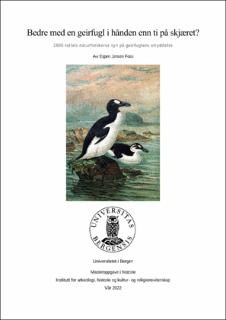| dc.description.abstract | This thesis aims to analyze the 19th century naturalists’ views on the extinction of the great auk. In the half-century following its extinction in 1844, several scientific papers were written on the bird, with many of the expressing an opinion on the manner of its disappearance. There are several factors to take into consideration when analyzing this subject, as the contemporary views on nature were quite different from todays. Many of these naturalists were influenced by the various theories of extinction and evolution that emerged in the early 19th century. Some of them follow the Darwinian theory of natural selection and viewed extinction as a result of more adapted species emerging. Others viewed man as a destructive influence on nature and criticized the exploitative nature of humans. In this thesis I discuss how the understanding of species classification affects how naturalists viewed the phenomenon of extinction. I argue that to be able to recognize extinction of species, it is essential to have knowledge of the difference between species. I provide an example of this in the case of the great auk, as it was often mistaken for other similar-looking birds, like the penguin and other diving birds. Among the naturalists mentioned in this thesis, there were different views on the causes of the extinction of the great auk. Some believed it to have gradually become scarcer, before being finished off by collectors in the early 1800s rather than being exclusively hunted to extinction. Some naturalists suggested a volcanic eruption as having made them more vulnerable to human predation towards the end. While others believed it to have been exterminated by humans due to limited knowledge about its scientific value. Several naturalists believed public knowledge of the problem of extinction was essential to prevent further extermination of other species. Towards the end of the century there seems to have been a general acceptance of human responsibility for the extinction of the great auk. Stricter laws were being introduced to prevent further destruction of wild animals, with a varying degree of success. The expressed motivations for protection of animals were often directed towards their usefulness to humans, whether practical or scientific. Nevertheless, the research on the extinction of the great auk provided knowledge on the process of extinction not widespread before the event. | |
